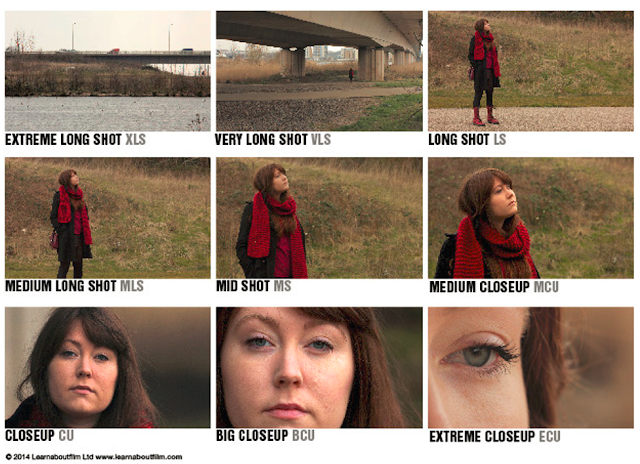Shot sizes
Shot sizes are how big things are in the
picture, and whether it mainly shows the setting, people in the setting, or details
of faces and things. Most filmmakers use standard names for shot sizes. What
really differentiates movies from plays is the way filmmakers manipulate the
audience’s field of view. In theatre, the audience is in a “wide shot,” always
looking at the entire stage and all the actors on it. They are free to look
wherever they want. In cinema, however, the filmmaker directs what the public
sees and how. While a long shot can show a vast vista of Mount Everest, an
extreme close-up can show the silent despair of a child learning that his
mother has passed away. These different shots make up the fabric of visual
storytelling.
Here are the various types of shot sizes used in
filmaking.
they are also the most common shots which are used in film.
Wide/Long Shot
 Long shots are used to emphasize a sweeping location around the subject.Long shot and wide shot are interchangeable terms.This frame from Gone with the Wind (1939) emphasizes
the tragedy of the Civil War and its death toll.
Long shots are used to emphasize a sweeping location around the subject.Long shot and wide shot are interchangeable terms.This frame from Gone with the Wind (1939) emphasizes
the tragedy of the Civil War and its death toll.
Medium Shot (MS)
 Medium shots are the most common types of shots in the movies. Showing
most of the subject’s body, medium shots are halfway between long shots and
close-ups; however, authors disagree on the definition. While some writers say
that the medium shot shows the character from a little above the knees to the
top of his head, others state that medium shots only go as low as a little
above the waist. Regardless of the academic debate, a medium shot is by all
definitions a happy medium between a full shot and a close-up.
Medium shots are the most common types of shots in the movies. Showing
most of the subject’s body, medium shots are halfway between long shots and
close-ups; however, authors disagree on the definition. While some writers say
that the medium shot shows the character from a little above the knees to the
top of his head, others state that medium shots only go as low as a little
above the waist. Regardless of the academic debate, a medium shot is by all
definitions a happy medium between a full shot and a close-up.
Close-Up (CU)
 In close-up shots, the subject occupies most of the frame, allowing very
little observation on the environment. Close-ups are much more dramatic than
long or medium shots and they are preferred when emphasizing someone’s emotion.
In close-up shots, the subject occupies most of the frame, allowing very
little observation on the environment. Close-ups are much more dramatic than
long or medium shots and they are preferred when emphasizing someone’s emotion.
Extreme Close-Up (ECU)
Often labelled as a
detail shot, extreme close-ups do exactly that: show a small detail that would
otherwise be missed in a winder shot.
Here is another guide to shot sizes and how, realistically they could be used.



No comments:
Post a Comment